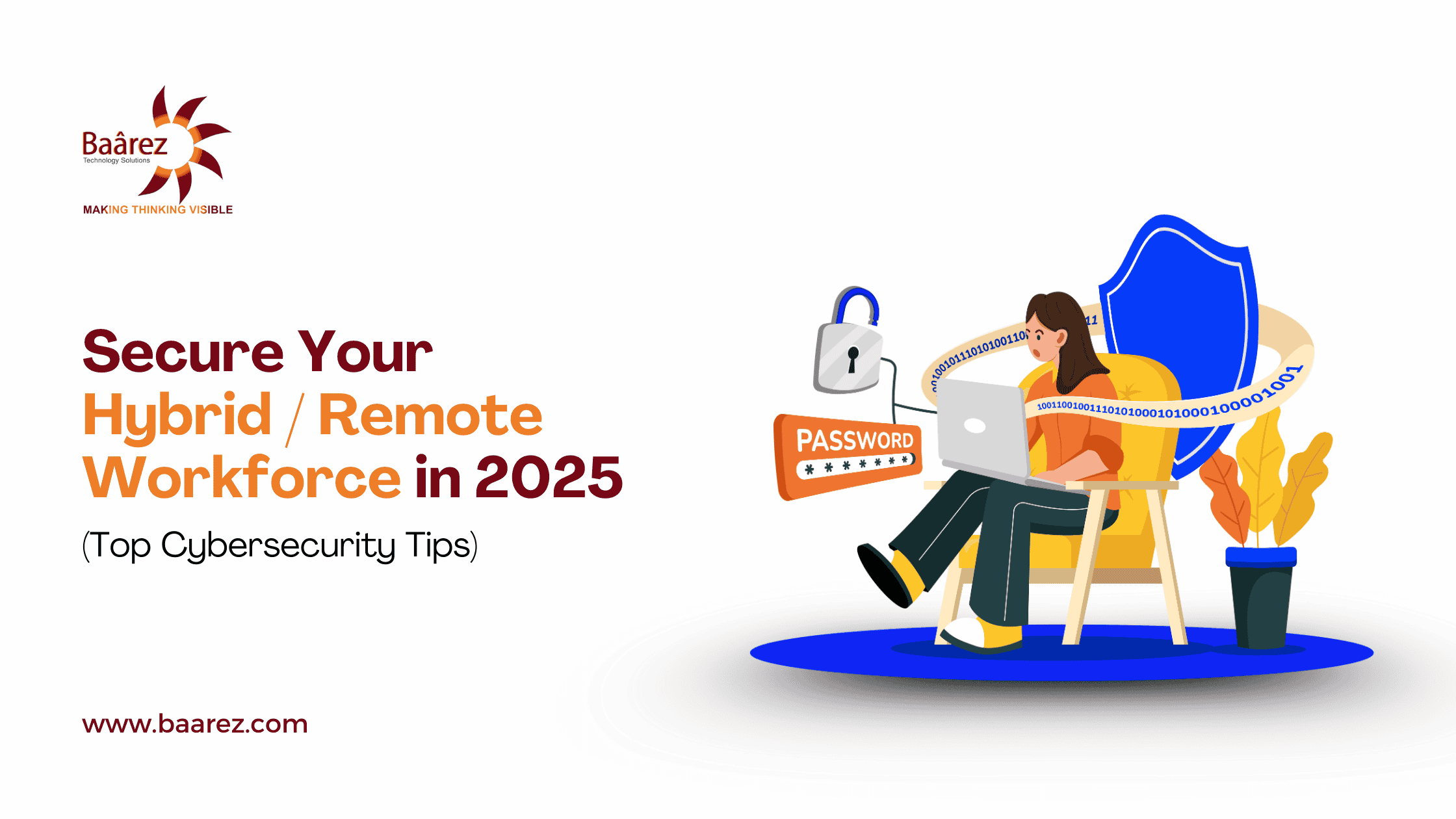
Hybrid work has redefined how organizations operate. While this model increases flexibility and productivity, it also brings significant cybersecurity challenges that can expose businesses to a wide range of risks. With the rise of remote and hybrid workforces, understanding and mitigating cybersecurity risks for hybrid workforces is more important than ever.
Table of Contents
ToggleWhat is a Hybrid Workforce? Why Does a Hybrid Workforce Need Strong Cybersecurity?
A hybrid workforce is a business model where employees split their time between working remotely and on-site. Some may work entirely from home, others from corporate offices, and many adopt a flexible, mixed approach depending on their roles and responsibilities.
According to Gartner, by 2026, nearly 70% of the global workforce will work remotely at least five days a month. This transition to hybrid models has created new opportunities—but also new cybersecurity risks.
Why strong cybersecurity is essential for hybrid workforces:
Hybrid work environments break away from the traditional security perimeter. Employees access sensitive business applications and data over home networks, public Wi-Fi, and personal devices. This expands the attack surface, making organizations more vulnerable to:
- Unauthorized access
- Data breaches
- Phishing attacks
- Malware infections
- Shadow IT risks
Unlike centralized, office-based setups where IT teams manage and monitor security protocols closely, hybrid work setups require distributed security that spans across multiple devices, networks, and locations.
Key Cybersecurity Risks in Hybrid Work Environments
Hybrid work environments bring efficiency and flexibility, but they also introduce several cybersecurity risks that are difficult to manage using traditional security models. These risks emerge because of inconsistent security policies, unsecured personal devices, and limited visibility across distributed networks. Let’s explore the most critical threats faced by hybrid workforces in 2025:
Unsecured Networks
Remote employees often connect to the internet via public Wi-Fi, home routers, or personal hotspots that lack proper encryption or updated firmware. These networks are soft targets for cybercriminals looking to intercept data or launch man-in-the-middle (MitM) attacks.
Key Risks of Unsecured Networks:
- Sensitive data transmitted without encryption
- Lack of intrusion detection systems (IDS)
- Susceptibility to DNS hijacking or spoofing
Weak Passwords
Password fatigue and poor password hygiene continue to be the weakest link in hybrid environments. Employees often reuse passwords across personal and professional accounts or choose easily guessable ones, exposing systems to credential stuffing and brute-force attacks.
Common Mistakes:
- Using “123456” or “Password@123”
- Reusing the same password across apps
- Not enabling two-factor authentication (2FA)
Insufficient Access Controls
In hybrid models, ensuring that employees only have access to what they need is vital. However, broad access rights, inactive accounts, and lack of role-based permissions can lead to insider threats and data leaks.
What causes insufficient access control?
- No identity governance framework
- Failure to revoke access for former employees
- Inability to enforce least privilege policies
Privacy and Compliance Risks
Hybrid workforces frequently operate across multiple jurisdictions, raising concerns around data privacy laws like GDPR, HIPAA, or UAE’s PDPL. Organizations may inadvertently store or process data in non-compliant ways, risking fines and reputation loss.
Challenges:
- Inconsistent encryption standards
- Lack of visibility into cloud data residency
- Difficulty maintaining audit trails across endpoints
Limited Threat Visibility and Monitoring
With remote employees scattered across locations, centralized IT teams lose visibility into all endpoints, devices, and traffic. This results in delayed detection, incomplete incident analysis, and ineffective responses.
Key limitations:
- Lack of real-time threat intelligence
- Difficulty correlating events across distributed systems
- Absence of behavioral analytics and endpoint detection
Common Attack Vectors Targeting Remote Employees
Cybercriminals are exploiting the vulnerabilities in hybrid workforces using targeted attack vectors that capitalize on remote employees’ less secure environments. These threats are increasing in frequency and sophistication, with attackers focusing on manipulating users and intercepting data outside corporate perimeters.
Below are the most common and dangerous attack vectors impacting hybrid workers today:
Phishing
Phishing is the most common method used to compromise remote employees. It involves sending deceptive emails, messages, or websites that trick users into disclosing credentials, downloading malware, or providing sensitive information.
Phishing Techniques in Hybrid Environments:
- Business Email Compromise (BEC): Spoofing a company executive’s email to authorize fake transactions.
- Fake IT support emails: Mimicking help desk requests to reset passwords.
- Collaboration tool impersonation: Fake Zoom or Microsoft Teams invites used to inject malware.
Credential Theft
With employees using cloud platforms, VPNs, and SaaS apps, stolen credentials provide easy access to enterprise systems. Threat actors often buy stolen credentials from the dark web or use brute-force methods to compromise accounts.
Tactics Used:
- Keylogging malware installed via email or downloads
- Browser credential harvesting
- Exploiting Single Sign-On (SSO) misconfigurations
Social Engineering
In hybrid setups, direct face-to-face communication is rare, making social engineering easier. Attackers exploit trust and impersonate vendors, co-workers, or IT support to deceive employees into granting access or sharing sensitive data.
Examples:
- Pretexting: Posing as legal or compliance staff requesting data.
- Vishing: Using voice calls to pressure users into actions like MFA code sharing.
- Deepfakes: AI-generated audio or video calls impersonating executives.
Man-in-the-Middle (MitM)
In a Man-in-the-Middle attack, an attacker secretly intercepts communication between two parties. These attacks are particularly effective when employees use public Wi-Fi or unsecured VPNs.
Risks of MitM for Hybrid Workers:
- Data interception during login or file transfers
- Session hijacking in collaboration platforms
- Fake SSL certificates tricking users into false trust
Ransomware and Malware
Ransomware and other malware often enter through phishing or insecure downloads. In hybrid environments, where antivirus coverage is inconsistent and devices may not be patched regularly, these attacks spread rapidly.
Notable Threats:
- Ransomware-as-a-Service (RaaS): Subscription-based ransomware attacks targeting small business networks.
- Spyware: Captures keystrokes and screenshots of remote sessions.
- Trojanized apps: Disguised as collaboration or productivity tools.
Essential Cybersecurity Strategies for Hybrid Workforces
With hybrid work becoming the norm, businesses need robust, layered cybersecurity strategies to protect data, users, and infrastructure. These strategies must account for remote connectivity, diverse endpoints, and cloud-native services, all while ensuring compliance and resilience.
Below are the top 9 cybersecurity strategies every hybrid organization should adopt in 2025:
1. Have a Proper Identity Governance Framework
A strong identity governance framework ensures that only the right users have the right access to the right resources, at the right time — and for the right reasons.
Key Practices:
- Implement Role-Based Access Control (RBAC)
- Enforce identity lifecycle management
- Regularly audit access logs and entitlements
2. Adopt a Zero Trust Architecture
Zero Trust means “never trust, always verify” — even inside the network. It’s essential for hybrid models where users work from various untrusted networks and devices.
Core Components:
- Micro-segmentation of resources
- Continuous user and device validation
- Least privilege access controls
3. Ensure Endpoint Protection
Every laptop, mobile device, and home desktop connecting to the corporate network becomes a potential attack surface. Endpoint security tools ensure these devices are secured, monitored, and up-to-date.
Must-Have Features:
- Antivirus and anti-malware software
- EDR (Endpoint Detection & Response)
- Automatic patch management
4. Enforce a Trusted Device Policy
A trusted device policy ensures that only compliant, secure, and managed devices can access corporate resources. This mitigates risks from BYOD or outdated personal systems.
Implementation Tips:
- Use MDM (Mobile Device Management) platforms
- Tag and register corporate devices
- Block access from jailbroken or rooted devices
5. Mandate Strong Network Security
All network connections — including VPNs, home Wi-Fi, and corporate WANs — must be secured with modern encryption and strict access control policies.
Key Tactics:
- Deploy next-gen firewalls
- Enforce VPN usage with MFA
- Enable split tunneling carefully to prevent data leaks
6. Adopt Cloud Security Measures
Hybrid work relies heavily on cloud platforms, making cloud security a must-have. Misconfigurations and lack of visibility are common weaknesses.
Best Practices:
- Use Cloud Security Posture Management (CSPM) tools
- Apply encryption at rest and in transit
- Enable data loss prevention (DLP) policies
7. Implement Robust Monitoring and Incident Response
Threat detection must be real-time and response should be automated where possible. Hybrid environments are too complex for manual-only interventions.
Recommendations:
- Deploy a SIEM (Security Information & Event Management) system
- Leverage SOAR (Security Orchestration, Automation and Response) platforms
- Set up 24/7 SOC (Security Operations Center) or outsource it to experts
8. Encourage ‘Bring Your Own Key’ (BYOK) Adoption
BYOK allows companies to encrypt their data in the cloud with their own encryption keys, giving them full control — critical for compliance and data ownership.
Advantages:
- Ensures data sovereignty
- Supports auditing and revocation
- Enhances trust in third-party cloud providers
9. Conduct Security Awareness Training
The most advanced security tools fail if employees don’t know how to avoid threats. Regular training ensures that hybrid teams recognize and report suspicious activity.
What Training Should Include:
- How to spot phishing emails
- Safe internet and software use
- Proper data sharing and handling protocols
- How to use VPNs and MFA effectively
Compliance Challenges for Hybrid Workforces
Hybrid workforces face a complex compliance landscape. With employees working across borders, using various devices and networks, and accessing sensitive data from the cloud, the risk of non-compliance skyrockets.
Organizations must understand the specific compliance risks and implement controls to ensure they’re adhering to regulatory standards like GDPR, HIPAA, and local data protection laws.
Data Privacy Challenges
Data privacy is especially tricky when data is:
- Accessed remotely
- Stored across multiple cloud environments
- Shared using third-party collaboration tools
Common Issues:
- Inadvertent exposure of personally identifiable information (PII)
- Lack of data classification and tagging
- No centralized data governance policy
Maintaining Robust Controls in Decentralized Environments
In a hybrid model, centralized IT governance becomes difficult. Users access resources from personal laptops, hotel Wi-Fi, or public hotspots. This decentralization weakens control enforcement.
Risks:
- Shadow IT — unsanctioned tools or apps used by remote staff
- Lack of uniform security policies
- Difficulty in tracking access logs and anomalies
Solution: Use unified endpoint management (UEM) tools and enforce consistent security policies across all user locations and devices.
Protecting Healthcare Information for Laws Like HIPAA
Healthcare organizations with hybrid staff must safeguard ePHI (electronic Protected Health Information) under HIPAA, which requires secure transmission, storage, and audit trails.
HIPAA Requirements for Hybrid Work:
- Encryption of data at rest and in transit
- Access logging and auditability
- Security awareness training for all staff
- Signed Business Associate Agreements (BAAs) with cloud vendors
HIPAA Compliance Area | Hybrid Work Consideration |
Access Controls | Use of MFA and RBAC for remote sessions |
Device Security | MDM on all endpoints accessing ePHI |
Network Security | VPN and firewall protections for home users |
Balancing Employee Monitoring and Employee Privacy
Monitoring employee activities is important for security, but it must be balanced against privacy rights, especially in regions like the EU where GDPR is enforced.
Tips for Ethical Monitoring:
- Be transparent — disclose what is monitored
- Monitor only business-related activities
- Use data minimization principles
- Ensure employee consent where required
Cross-Border Data Transfers
When employees access corporate systems from different countries, data may be transferred across jurisdictions — each with its own data sovereignty laws.
Considerations:
- Is data stored in a region with weaker privacy protections?
- Have you adopted Standard Contractual Clauses (SCCs) or other legal mechanisms?
- Are you using data localization strategies where required?
Role of Employee Cybersecurity Awareness Training
Even the most sophisticated cybersecurity systems can be compromised by a single careless click. In hybrid workforces, where employees operate from diverse locations and networks, human error becomes the biggest vulnerability. That’s why cybersecurity awareness training is non-negotiable.
A well-informed workforce is your first line of defense. Training helps employees recognize, avoid, and report threats — reducing your attack surface significantly.
Why Is Cybersecurity Training Critical in Hybrid Environments?
- Dispersed teams = More vectors of attack
- Remote employees often use personal devices and networks
- Lack of immediate IT oversight increases response time to threats
- Attackers target human psychology with phishing and social engineering
Core Components of Effective Cybersecurity Training
A strong cybersecurity awareness program must go beyond boring lectures. It should be interactive, continuous, and scenario-based.
Must-Have Topics:
Topic | Why It Matters |
Phishing Awareness | Teach employees to identify suspicious emails and URLs |
Safe Internet Habits | Prevent malware and data leakage via careless browsing |
Password Hygiene | Encourage strong, unique passwords and use of password managers |
Using MFA | Reinforce the importance of multi-factor authentication |
Device Security | Educate on securing laptops, phones, and tablets in public places |
Incident Reporting | Empower employees to report suspicious activity quickly |
Best Practices for Training Hybrid Teams
- Microlearning Modules: Bite-sized lessons delivered monthly
- Gamified Simulations: Turn phishing detection into a competitive team activity
- Role-Based Training: Customize based on department (e.g., finance vs. marketing)
- Quarterly Live Sessions: Led by internal security teams or external experts
- Annual Red Team Exercises: Simulate breaches to test response readiness
Building a Cyber-Aware Culture
Training should not be a once-a-year checkbox. Make cybersecurity part of your organizational culture:
- Celebrate “Cyber Awareness Week”
- Share real-world attack stories
- Recognize employees who report threats
- Involve leadership to reinforce importance
How Baarez Helps Secure Hybrid Work Environments
As hybrid work becomes the norm, organizations need specialized, scalable, and compliant security solutions. Baarez Technology Solutions delivers a comprehensive cybersecurity ecosystem tailored for hybrid workplaces — ensuring that employees, data, and devices are protected, no matter where work happens.
1. Zero Trust Architecture Deployment
Baarez helps enterprises implement a Zero Trust framework — where every user and device must be verified before accessing any system.
- Identity-centric security with risk-based authentication
- Least privilege access for all users
- Continuous validation of session behavior
2. Cloud Security Posture Management (CSPM)
With data increasingly stored across cloud services like Azure, AWS, and Google Cloud, Baarez enables real-time cloud misconfiguration detection and policy enforcement.
Features:
- Visibility into cloud assets
- Automated remediation of misconfigurations
- Compliance monitoring against standards like CIS, GDPR, and HIPAA
3. Unified Endpoint Protection (UEP)
Securing endpoints in a hybrid setting is critical. Baarez deploys UEP solutions that cover both corporate and personal devices:
- Antivirus + EDR (Endpoint Detection & Response)
- Mobile Device Management (MDM)
- Patch management and device health analytics
4. Identity Governance & Privileged Access Management
Baarez ensures secure identity lifecycle management and helps businesses govern user access to sensitive systems.
Solution | Key Capabilities |
Identity Governance | Automated user provisioning/deprovisioning, access reviews |
Privileged Access Management (PAM) | Just-in-time access, session recording, password vaulting |
5. Security Operations Center (SOC) as a Service
Baarez offers 24/7 SOC monitoring with AI-driven threat detection and incident response. This gives hybrid organizations real-time visibility into threats across their distributed infrastructure.
6. Cybersecurity Awareness Programs
In addition to tech, Baarez offers custom security training programs:
- Interactive modules tailored to industry and roles
- Compliance-aligned (ISO 27001, GDPR)
- Phishing simulations and behavior analytics
7. Compliance Consulting for Hybrid Models
Whether it’s GDPR, HIPAA, or local laws like UAE’s Personal Data Protection Law (PDPL), Baarez provides expert guidance:
- Compliance audits and gap assessments
- Remediation roadmaps
- Documentation and reporting tools
Why Choose Baarez for Hybrid/Remote Cybersecurity?
- Proven expertise in securing remote and hybrid environments
- Tailored cybersecurity frameworks aligned with business goals
- 24/7 support and managed services
- Strategic partnerships with Microsoft, IBM, Oracle, and more
FAQs on Cybersecurity for Hybrid Workforces
-
1. What’s the role of the zero trust security model in hybrid workforce protection?
The Zero Trust model is essential in hybrid settings because it eliminates implicit trust in any user, device, or network — whether internal or external. Instead of assuming that everything behind the firewall is safe, Zero Trust continuously verifies all connections.
Key benefits include:
- Strong access control policies
- Identity-based verification before allowing access
- Reduced risk of lateral movement by attackers
- Enhanced protection against insider threats
- Strong access control policies
-
2. What are the key concerns for cloud security in hybrid environments?
Hybrid workforces rely heavily on cloud infrastructure. Key concerns include:
- Misconfigured resources (e.g., public S3 buckets)
- Lack of visibility into multi-cloud environments
- Inconsistent security policies across platforms
- Unencrypted sensitive data
- Shadow IT usage without governance
- Misconfigured resources (e.g., public S3 buckets)
-
3. What security measures should be adopted for BYOD devices?
Bring Your Own Device (BYOD) introduces major risks if unmanaged. To secure BYOD devices in a hybrid workforce:
- Enforce Mobile Device Management (MDM)
- Require device-level encryption
- Use containerization to separate work/personal data
- Apply strong password policies and biometrics
- Restrict access from rooted/jailbroken devices
- Use VPNs and endpoint protection tools


